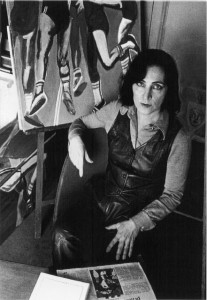In her work, Silvia Ocampo has captured, with vitality and sensitivity, the social problems of her time. After graduating as a professor of Fine Arts, she joined the art studio of master Demetrio Urruchúa and took charge of it when, in 1955, the master was captured. She gave birth to the Del Plata Group. As a painter and designer, Silvia felt excluded for being a woman. In reaction to that, she made a study of the situation faced by professional women and wrote two essays on the matter. She also founded a virtual museum of women artists.
Her mother gave birth to her in La Rioja, a province in the countryside of Argentina. But it was the capital city of Buenos Aires that gave birth to her as an artist and a woman aware of herself and her surroundings. She is Silvia Ocampo, a painter, feminist and social fighter. Soon after her graduation from the National School of Fine Arts, she joined the art studio of master Demetrio Urruchúa, a painter with a social conscience who was convinced that the militancy of an artist must be reflected in his or her work. And Silvia, who had always been a non-conformist, absorbed that message. She took charge of the master’s studio when, in 1955, he was captured as part of the repression Peron’s government exercised against the people they considered as their ideological enemies. Along with other young male and female artists, Silvia Ocampo gave birth to the Del Plata Group, which arose from the studio of Urruchúa, and continued until its dissolution in 1964. This would be a time of integrated learning. She has witnessed many things: the time of her master’s detention; the cultural revolution of 1968; the vindication of the feminists; the repression carried out by the military dictatorship (1976-1983); the war between her country and Great Britain for the Falkland Islands in 1982; and the corruption of the democratic governments. She has always been on the side of justice and peace. She has written about her feminism in two essays: Equilibrium between the sexesAn analysis of the feminine matter (1980) and Male and Female Roles, Conditioning or Biology? (1987). In 1997, she created the virtual Museo Argentino de Artistas Plásticas (Argentine Museum of Women Artists) on the internet, and now she is trying to make it real, through the creation of the Association of Friends of the Museum.
Museo Argentino de Artistas Plásticas (Argentine Museum of Women Artists) Association of Friends of the Museum
Latin America and the Carribeans | Argentina

